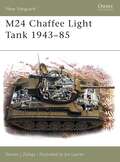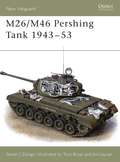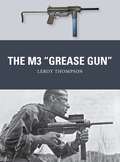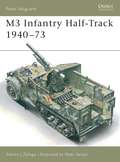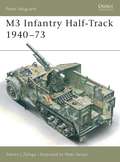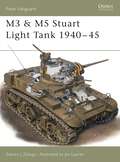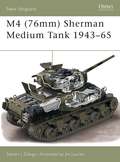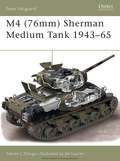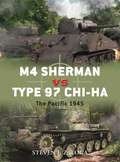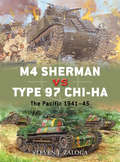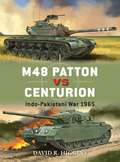- Table View
- List View
M24 Chaffee Light Tank 1943–85 (New Vanguard)
by Steven J. ZalogaThe history of US light tanks during World War II is a chequered one. The Light Battalions of US Armored Divisions were initially filled with M3A1 and M5 Stuart tanks, however, on the battlefields of North Africa it was realised that these were disastrously under armoured and gunned, and a replacement, or the abandonment of light tank doctrine, was desperately needed. It wasn't until the last few months of WWII that the M24 Chaffee came into service and it was extensively used in combat from the Battle of the Bulge to the final campaigns in Germany. This book will trace the history of this design, its combat record in World War II, its many variants, and its extensive combat record post 1945.
M26/M46 Pershing Tank 1943–53 (New Vanguard #35)
by Steven J. ZalogaFrom the moment that the M4 Sherman had been matched against German Panther and Tiger tanks, the American tank crews had known that their vehicles were outclassed by the opposition. What was needed was a more powerful tank, more heavily armed and armored, that could take-on the powerful German panzers on a more equal footing. Although it took time to develop by the latter months of the war numbers of M26 Pershing tanks were reaching the frontline US armored units. Well armored and with a powerful 90mm gun the Pershing was a match for any tank in the German order of battle.
M26/M46 Pershing Tank 1943–53 (New Vanguard #35)
by Steven J. Zaloga Jim Laurier Tony BryanFrom the moment that the M4 Sherman had been matched against German Panther and Tiger tanks, the American tank crews had known that their vehicles were outclassed by the opposition. What was needed was a more powerful tank, more heavily armed and armored, that could take-on the powerful German panzers on a more equal footing. Although it took time to develop by the latter months of the war numbers of M26 Pershing tanks were reaching the frontline US armored units. Well armored and with a powerful 90mm gun the Pershing was a match for any tank in the German order of battle.
The M3 "Grease Gun" (Weapon)
by Adam Hook Leroy Thompson Alan GillilandInfluenced by the German MP 40 and the British Sten, the .45-caliber M3 "Grease Gun†? served as the primary US submachine gun for almost a half-century. Designed to replace the expensive Thompson SMG, the M3 was issued to airborne troops and others during World War II thanks to its compact design with sliding wire stock. An improved variant, the M3A1, was favored by armored crews right up to the beginning of the 1990s, seeing service in 1991's Operation Desert Storm. In Korea and Vietnam, reconnaissance troops and special-operations forces were at times armed with the M3A1 – also available in a suppressed version – and it was the first SMG issued to the US counterterrorist unit Delta Force. Featuring full-color artwork, first-hand accounts, and archive and close-up photographs, this is the engaging story of the M3 submachine gun.
The M3 "Grease Gun" (Weapon #46)
by Leroy Thompson Mr Adam Hook Alan GillilandInfluenced by the German MP 40 and the British Sten, the .45-caliber M3 "Grease Gun†? served as the primary US submachine gun for almost a half-century. Designed to replace the expensive Thompson SMG, the M3 was issued to airborne troops and others during World War II thanks to its compact design with sliding wire stock. An improved variant, the M3A1, was favored by armored crews right up to the beginning of the 1990s, seeing service in 1991's Operation Desert Storm. In Korea and Vietnam, reconnaissance troops and special-operations forces were at times armed with the M3A1 – also available in a suppressed version – and it was the first SMG issued to the US counterterrorist unit Delta Force. Featuring full-color artwork, first-hand accounts, and archive and close-up photographs, this is the engaging story of the M3 submachine gun.
M3 Infantry Half-Track 1940–73 (New Vanguard)
by Steven J. Zaloga Peter SarsonAs armoured warfare tactics matured, mechanised infantry became a key ingredient in what is now called 'combined arms' doctrine. For the US Army of World War 2, the most important technical aspect of infantry mechanisation was the development of the M3 half-track personnel carrier. Steven Zaloga guides the reader through the early 1930s development of the half-track, its first deployment in action in the Philippines in 1941 and its varied and vital role in international deployments since World War 2. This authoritative text also examines the operators of half-tracks and the troops that they carried.
M3 Infantry Half-Track 1940–73 (New Vanguard #11)
by Steven J. Zaloga Peter SarsonAs armoured warfare tactics matured, mechanised infantry became a key ingredient in what is now called 'combined arms' doctrine. For the US Army of World War 2, the most important technical aspect of infantry mechanisation was the development of the M3 half-track personnel carrier. Steven Zaloga guides the reader through the early 1930s development of the half-track, its first deployment in action in the Philippines in 1941 and its varied and vital role in international deployments since World War 2. This authoritative text also examines the operators of half-tracks and the troops that they carried.
M3 Lee/Grant Medium Tank 1941–45 (New Vanguard)
by Hugh Johnson Steven J. ZalogaThe highly successful 'stop-gap' M3 medium tank was designed in 1941, and as adequate turret casting facilities were not yet ready, the M3 used an unusual armament configuration patterned after a French tank. British lend-lease demands led to the design of a second turret type with the US version called the Lee and the British version the Grant. It could penetrate Panzer armor, and its explosive firepower was excellent for dealing with German anti-tank guns. This book covers the design, development, service and variants of a vehicle that was the backbone of many World War II forces.
M3 Lee/Grant Medium Tank 1941–45 (New Vanguard)
by Hugh Johnson Steven J. ZalogaThe highly successful 'stop-gap' M3 medium tank was designed in 1941, and as adequate turret casting facilities were not yet ready, the M3 used an unusual armament configuration patterned after a French tank. British lend-lease demands led to the design of a second turret type with the US version called the Lee and the British version the Grant. It could penetrate Panzer armor, and its explosive firepower was excellent for dealing with German anti-tank guns. This book covers the design, development, service and variants of a vehicle that was the backbone of many World War II forces.
M3 & M5 Stuart Light Tank 1940–45 (New Vanguard)
by Steven J. ZalogaThe M3 and M5 family of light tanks were the culmination of American tank development of the 1930s. By the time of the outbreak of the World War II, they were approaching obsolescence, as tank forces in Europe were shifting from light to medium tanks as the main element of their armored forces. First entering combat in the autumn of 1941 in the Western Desert with the British Army, the Stuart quickly proved its inadequacies. The M3 and M5 light tanks proved more suitable in the Pacific theater than in Europe, and fought successfully in many of the major battles including Guadalcanal, Tarawa and Peleliu. This title narrates this distinctive and unusual fighting vehicle's history.
M3 & M5 Stuart Light Tank 1940–45 (New Vanguard)
by Steven J. ZalogaThe M3 and M5 family of light tanks were the culmination of American tank development of the 1930s. By the time of the outbreak of the World War II, they were approaching obsolescence, as tank forces in Europe were shifting from light to medium tanks as the main element of their armored forces. First entering combat in the autumn of 1941 in the Western Desert with the British Army, the Stuart quickly proved its inadequacies. The M3 and M5 light tanks proved more suitable in the Pacific theater than in Europe, and fought successfully in many of the major battles including Guadalcanal, Tarawa and Peleliu. This title narrates this distinctive and unusual fighting vehicle's history.
M3 Medium Tank vs Panzer III: Kasserine Pass 1943 (Duel)
by Gordon L. Rottman Ian Palmer Giuseppe RavaThis was a duel between the stalwart of the Wehrmacht armored divisions the Panzerkampfwagen III and the American's as yet untested M3 Grant. In reality both would prove unequal to the task as they floundered amidst the rugged hills and ravines of the Tunisian landscape. This book charts the design and development of these two disparate rivals their vastly different armament and armor as well as their tactical concepts. Analysing the strengths and weaknesses of these two opponents, this book explores the successes and failures of the Grant and Panzer III as they clashed at the critical battles of North Africa. Moreover it is an insight into the lives of the tank crews themselves as they struggled with the twin horrors of tank warfare and the fight for survival amidst some of the most inhospitable terrain on earth.
M3 Medium Tank vs Panzer III: Kasserine Pass 1943 (Duel)
by Gordon L. Rottman Giuseppe Rava Mr Ian PalmerThis was a duel between the stalwart of the Wehrmacht armored divisions the Panzerkampfwagen III and the American's as yet untested M3 Grant. In reality both would prove unequal to the task as they floundered amidst the rugged hills and ravines of the Tunisian landscape. This book charts the design and development of these two disparate rivals their vastly different armament and armor as well as their tactical concepts. Analysing the strengths and weaknesses of these two opponents, this book explores the successes and failures of the Grant and Panzer III as they clashed at the critical battles of North Africa. Moreover it is an insight into the lives of the tank crews themselves as they struggled with the twin horrors of tank warfare and the fight for survival amidst some of the most inhospitable terrain on earth.
M4 (New Vanguard)
by Steven J. Zaloga Jim LaurierThe M4 Sherman tank was the mainstay of the Western allies between 1942 and 1945. Fast and modern it was a big success and was transported as far afield as Russia and North Africa. The American Chief of Staff claimed in November 1943 it was 'hailed widely as the best tank on the battlefield today…'. However, by the Normandy invasion of June 1944 this was not the case: the new German heavy tanks such as the Panther and Tiger were completely outclassing the Sherman. This title covers the M4 version armed with the 76 mm gun, examining developments such as the HVSS suspension, using much new archive material.
M4 (New Vanguard #73)
by Steven J. Zaloga Jim LaurierThe M4 Sherman tank was the mainstay of the Western allies between 1942 and 1945. Fast and modern it was a big success and was transported as far afield as Russia and North Africa. The American Chief of Staff claimed in November 1943 it was 'hailed widely as the best tank on the battlefield today…'. However, by the Normandy invasion of June 1944 this was not the case: the new German heavy tanks such as the Panther and Tiger were completely outclassing the Sherman. This title covers the M4 version armed with the 76 mm gun, examining developments such as the HVSS suspension, using much new archive material.
The M4 Carbine (Weapon)
by Chris McNabThe M4 carbine has become one of the defining military firearms of the late 20th and early 21st centuries. Developed as a fusion of the XM177E2 Colt Commando and the M16A2 assault rifle, the M4 offered a more convenient battlefield firearm than the full-length M16 variants, and the US Army adopted it as the standard infantry weapon in the 1990s. Today, military and law-enforcement personnel of more than 60 countries have adopted either the M4 or the M4A1 variant, both of which have been tested and proven in major combat operations worldwide.This study describes the development process in detail, from production of the first XM4 prototypes in 1984 through numerous modified types until it emerged into official use as the M4 in 1994. The M4 offered a weapon that was 1lb lighter and 6in shorter than the standard M16A2, yet could still deliver precision semi-auto and full-auto firepower up to an effective range of 500m. Over time, its capabilities have been enhanced by the M4A1 modifications plus an extensive range of tactical accessories, including optical day/night sights, laser/infrared designators, under-barrel grenade launchers and shotgun modules, foregrips, furniture options, mounting rails, and sound suppressors. Numerous M4/M4A1 combat operations are investigated to reveal why the weapon has received such high levels of approval by front-line combat troops, not only in Afghanistan and Iraq, where the M4/M4A1 has been intensively combat-tested, but also in contexts such as Colombia, India, Israel, and the Philippines. Profusely illustrated with photographs and artworks, and drawing its research from the latest declassified documents, this is a complete guide to one of the most important and widely distributed tactical infantry weapons of the last quarter-century.
The M4 Carbine (Weapon #77)
by Chris McNabThe M4 carbine has become one of the defining military firearms of the late 20th and early 21st centuries. Developed as a fusion of the XM177E2 Colt Commando and the M16A2 assault rifle, the M4 offered a more convenient battlefield firearm than the full-length M16 variants, and the US Army adopted it as the standard infantry weapon in the 1990s. Today, military and law-enforcement personnel of more than 60 countries have adopted either the M4 or the M4A1 variant, both of which have been tested and proven in major combat operations worldwide.This study describes the development process in detail, from production of the first XM4 prototypes in 1984 through numerous modified types until it emerged into official use as the M4 in 1994. The M4 offered a weapon that was 1lb lighter and 6in shorter than the standard M16A2, yet could still deliver precision semi-auto and full-auto firepower up to an effective range of 500m. Over time, its capabilities have been enhanced by the M4A1 modifications plus an extensive range of tactical accessories, including optical day/night sights, laser/infrared designators, under-barrel grenade launchers and shotgun modules, foregrips, furniture options, mounting rails, and sound suppressors. Numerous M4/M4A1 combat operations are investigated to reveal why the weapon has received such high levels of approval by front-line combat troops, not only in Afghanistan and Iraq, where the M4/M4A1 has been intensively combat-tested, but also in contexts such as Colombia, India, Israel, and the Philippines. Profusely illustrated with photographs and artworks, and drawing its research from the latest declassified documents, this is a complete guide to one of the most important and widely distributed tactical infantry weapons of the last quarter-century.
M4 Sherman vs Type 97 Chi-Ha: The Pacific 1945 (Duel #43)
by Steven J. Zaloga Richard ChasemoreAlthough US and Japanese tank forces first clashed in 1941, it was on in 1944 that tank-vs-tank action became more common as both sides poured larger numbers of tanks into the combat zone. These battles were a means of demonstrating each side's latest tank technology. For the US, the pinnacle of their tank machinery came in the form of the M4 Sherman and for the Japanese, their most notable feat of engineering was the smaller, yet still effective Type 97 Chi-Ha. The last two campaigns of the war – Iwo Jima and Okinawa – saw tanks used by both sides, the Japanese finally concluding that "the fight against the US Army is a fight against his M4 tanks†?. The illustrations follow the usual Duel pattern with profile illustrations of the Type 97-kai Shinhoto Chi-ha and the M4A3, views showing the ammunition of both types, interior illustrations showing the turret layout in both types, and a battlescene showing the Type 97-kai in combat against US armour.
M4 Sherman vs Type 97 Chi-Ha: The Pacific 1945 (Duel #43)
by Steven J. Zaloga Richard ChasemoreAlthough US and Japanese tank forces first clashed in 1941, it was on in 1944 that tank-vs-tank action became more common as both sides poured larger numbers of tanks into the combat zone. These battles were a means of demonstrating each side's latest tank technology. For the US, the pinnacle of their tank machinery came in the form of the M4 Sherman and for the Japanese, their most notable feat of engineering was the smaller, yet still effective Type 97 Chi-Ha. The last two campaigns of the war – Iwo Jima and Okinawa – saw tanks used by both sides, the Japanese finally concluding that "the fight against the US Army is a fight against his M4 tanks†?. The illustrations follow the usual Duel pattern with profile illustrations of the Type 97-kai Shinhoto Chi-ha and the M4A3, views showing the ammunition of both types, interior illustrations showing the turret layout in both types, and a battlescene showing the Type 97-kai in combat against US armour.
M48 Patton vs Centurion: Indo-Pakistani War 1965 (Duel)
by Johnny Shumate David R. Higgins Alan GillilandThe Indo-Pakistani War of 1965 witnessed some of the largest tank battles since World War II, notably between India's British-made Centurion Mk 7s and the American-made M48 Pattons fielded by Pakistan. The two countries' tank regiments, many of which shared a proud legacy in the British Indian Army, fought one another in the difficult terrain of Jammu and Kashmir, the focus of a long-running dispute between India and Pakistan. The armoured clashes at Asal Uttar, Chawinda and Phillora would demonstrate that the Centurion, with its powerful gun and lower profile, generally proved superior to the faster, lighter but overly complex Patton. Featuring full-colour artwork, expert analysis and archive photographs, this is the full story of the clash between two leading tanks of the Cold War era that were never designed to fight each other, but rather to line up on battlefields as allies.
M48 Patton vs Centurion: Indo-Pakistani War 1965 (Duel #71)
by Johnny Shumate David R. Higgins Alan GillilandThe Indo-Pakistani War of 1965 witnessed some of the largest tank battles since World War II, notably between India's British-made Centurion Mk 7s and the American-made M48 Pattons fielded by Pakistan. The two countries' tank regiments, many of which shared a proud legacy in the British Indian Army, fought one another in the difficult terrain of Jammu and Kashmir, the focus of a long-running dispute between India and Pakistan. The armoured clashes at Asal Uttar, Chawinda and Phillora would demonstrate that the Centurion, with its powerful gun and lower profile, generally proved superior to the faster, lighter but overly complex Patton. Featuring full-colour artwork, expert analysis and archive photographs, this is the full story of the clash between two leading tanks of the Cold War era that were never designed to fight each other, but rather to line up on battlefields as allies.
M50 Ontos and M56 Scorpion 1956–70: US Tank Destroyers of the Vietnam War (New Vanguard #240)
by Kenneth W EstesDesigned in the 1950s, the US Marines' M50 Ontos and the US Army's M56 Scorpion were both intended to be fast, light, air-droppable tank-killers for the Cold War battlefield – an answer to the cumbersome and ineffective World War II-vintage tanks that had taken to the battlefield during the Korean War. Although they shared the aim of bringing light, mobile and lethal antitank firepower to the infantry the two vehicles varied wildly in design to cater for their unique mission demands. They first saw service in the Lebanon intervention of 1958 but it was in the Vietnam War that they made their name, with the M50 Ontos seeing intense combat action in the Battle of Hue in 1968.Detailed illustrations and expert analysis provide the reader with a comprehensive history of these deadly antitank vehicles, from early development through to their combat history and the eventual disbandment of the Marine Corps' last antitank battalion with M50A1s in 1971.
M50 Ontos and M56 Scorpion 1956–70: US Tank Destroyers of the Vietnam War (New Vanguard)
by Johnny Shumate Henry Morshead Kenneth W EstesDesigned in the 1950s, the US Marines' M50 Ontos and the US Army's M56 Scorpion were both intended to be fast, light, air-droppable tank-killers for the Cold War battlefield – an answer to the cumbersome and ineffective World War II-vintage tanks that had taken to the battlefield during the Korean War. Although they shared the aim of bringing light, mobile and lethal antitank firepower to the infantry the two vehicles varied wildly in design to cater for their unique mission demands. They first saw service in the Lebanon intervention of 1958 but it was in the Vietnam War that they made their name, with the M50 Ontos seeing intense combat action in the Battle of Hue in 1968.Detailed illustrations and expert analysis provide the reader with a comprehensive history of these deadly antitank vehicles, from early development through to their combat history and the eventual disbandment of the Marine Corps' last antitank battalion with M50A1s in 1971.
M551 Sheridan: US Airmobile Tanks 1941–2001 (New Vanguard #153)
by Steven J. ZalogaALSO AVAILABLE TO BUY AS AN E-BOOK. Since the advent of airmobile warfare, there have been numerous attempts to support paratroopers with attached armored vehicles. This book tells the story of the US experience with air-mobile tanks, starting with their efforts in World War II. However, full success was not achieved until the production of the M551 Sheridan. The history of this tank provides the focal point of this book, highlighting the difficulties of combining heavy firepower in a chassis light enough for airborne delivery. The book examines its controversial debut in Vietnam, and its subsequent combat history in Panama and Operation Desert Storm. It rounds out the story by examining the failed attempts to replace the Sheridan with other armored vehicles.
M551 Sheridan: US Airmobile Tanks 1941–2001 (New Vanguard)
by Steven J. Zaloga Tony BryanSince the advent of airmobile warfare, there have been numerous attempts to support paratroopers with attached armored vehicles. This book tells the story of the US experience with air-mobile tanks, starting with their efforts in World War II. However, full success was not achieved until the production of the M551 Sheridan. The history of this tank provides the focal point of this book, highlighting the difficulties of combining heavy firepower in a chassis light enough for airborne delivery. The book examines its controversial debut in Vietnam, and its subsequent combat history in Panama and Operation Desert Storm. It rounds out the story by examining the failed attempts to replace the Sheridan with other armored vehicles.
